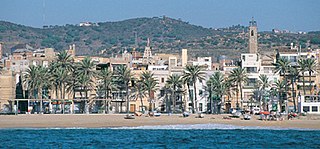
Badalona is a municipality to the immediate north east of Barcelona in Catalonia, Spain. It is located on the left bank of the Besòs River and on the Mediterranean Sea, in the Barcelona metropolitan area. By population, it is the third largest city in Catalonia and the twenty-third in Spain. It became a city in 1897.

Josep Domènech i Estapà was a Catalan architect.

L'Esquella de la Torratxa was an illustrated satirical weekly magazine, written in Catalan. Published in Barcelona between 1872 and 1939, it was well known for its pro-republican and anti-clerical stance and would become one of the most important Catalan publications of all times.
Arc Voltaic was a Catalan poetry magazine published in the city of Barcelona.
La Mà trencada is a Catalan magazine directed and edited by Joan Merlí. It was published for the first time on 6 November 1924, and it continued publishing every fortnight until 31 January 1925. However, in the book from Torrent and Tassis there is a mistake and it is written that the last number was published on 15 January 1926. Related with the format of the magazine, it had a measurement of 270x210 mm. Moreover, it was printed in the printing house “Omega”, which was situated in the Street Ample 53 in Barcelona, Spain. Each number consisted in 20 pages in two columns and it cost a peseta. The presentation of the magazine was very elegant with numerous images dedicated to modern Catalan artists.
Meridià was a Catalan magazine published every week and directed by A. Fuster Valldeperas. The first issue was published 14 January 1938, and it was published more than fifty times until 14 January 1939. The historical context is the Spanish Civil War that took place from 1936 until 1939.

Lo Noy de la mare was a humoristic and satiric weekly publication. It was written and directed by Conrad Roure, who used the pseudonym of Pau Bunyegas, among others. It was drawn by Tomás Padró. These two authors had previously worked in the magazine called “Un Tros de paper” and they decided to leave this publication to do “Lo Noy de la mare”. This magazine was first published in Barcelona in 1885, and it continued until 1886, with a total of 33 numbers. The magazine had a measurement of 310x217 mm and it contained 4 pages with 3 columns each. It had an enormous success but it had to be cancelled due to the moment circumstances, which were not good for criticism.

Quaderns de poesia is a poetry Catalan magazine. Its publication started in June 1935 and continued until 1936 when it had to be interrupted due to the Spanish Civil War. In total 8 volumes were published monthly. It was directed by a staff including Josep Vicenç Foix, Tomàs Garcés, Marià Manent, Carles Riba and Joan Teixidor. It was a high quality magazine regarding its presentation and its content. The magazine had 32 pages with 2 columns each and the dimensions were 240x185mm. The impression was done in Castells Bonet, S.A. and the editing office was in the Street Carrer de les Corts Catalanes 660 in Barcelona. The price was one and a half peseta.
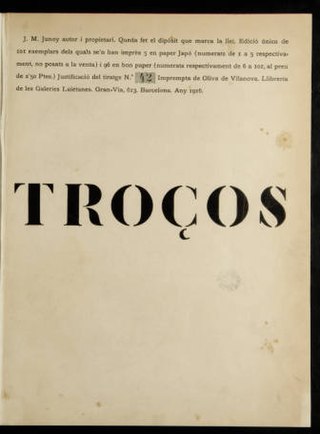
Troços is an avant-garde Catalan magazine published for the first time in 1916. It was directed by Josep Maria Junoy, who was also the owner of the magazine. Only 101 copies were printed of the first edition. This number had 8 pages and the measurements were 223 x 135 mm. Its impression was a high quality one and it was done in the printing house Oliva de Vilanova. Its price was 2.50 pesetas.

Vell i Nou was a Catalan magazine dedicated to arts that was established in March 1915. Its owner and editor-in-chief was Santiago Segura i Burguess. Later, the magazine was edited by other people, such as Joaquim Folch i Torres, Romà Jori, and Joan Sacs. The format of the magazine was 4 pages measuring 367x270 mm with 3 columns each. It was published weekly until April 10, when it started to appear every fortnight. The editorial office was situated in the Galeries Laietanes (Barcelona). Initially it was printed by F. Borràs, but later changed to other printers such as Oliva de Vilanova.

Art jove was a Catalan magazine, first published on 15 December 1905. The magazine was directed by Sebastià Xanxó and was published every fortnight. It was printed in the printing house “La Catalana” which was in Balmes Street, Barcelona. Regarding its format, it had a measurement of 221x140mm, and it cost 15 cents of peseta. It disappeared on 31 October 1906 with a total of 22 issues.
Última Hora is the best selling newspaper in the Balearic Islands founded by Josep Tous Ferrer on 1 May 1893, published by Hora Nova S.A. and belong to Grupo Serra, a mass communication company. The publication is dedicated to local news and has been distinguished with the Gold Medal of the City of Palma from the Confederación de Asociaciones Empresariales de las Baleares (CAEB).

The Catalan Republic was a state proclaimed in 1931 by Francesc Macià as the "Catalan Republic within the Iberian Federation", in the context of the proclamation of the Second Spanish Republic. It was proclaimed on 14 April 1931, and superseded three days later, on 17 April, by the Generalitat de Catalunya, the Catalan institution of self-government within the Spanish Republic.

Anton Ferrer y Codina was a Spanish playwright and newspaper writer.
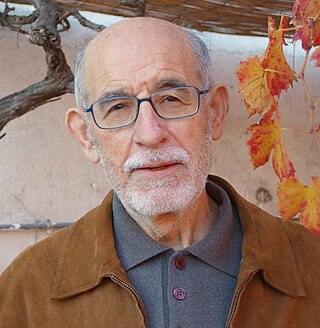
Joan Solà Cortassa was a Spanish linguist and philologist. He was professor of Catalan language and literature at the University of Barcelona from 1984 onwards, and vice president of the Institut d'Estudis Catalans (IEC) from 2009.

La Veu de Catalunya was a Catalan newspaper founded by Enric Prat de la Riba that was published in Barcelona from 1 January 1899 to 8 January 1937, with two editions daily.
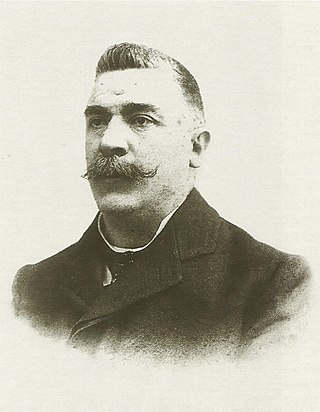
Joaquim Palay i Jaurés (1855–1928) was a Spanish industrialist and politician born in Uruguay, who was mayor of Badalona twice.
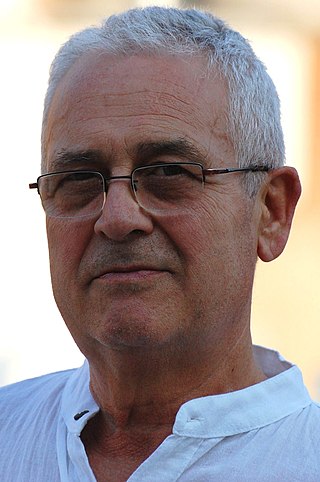
Joan Soler i Amigó was a Spanish writer and teacher.

Toni Soler i Guasch is a Spanish journalist, television producer and writer.















